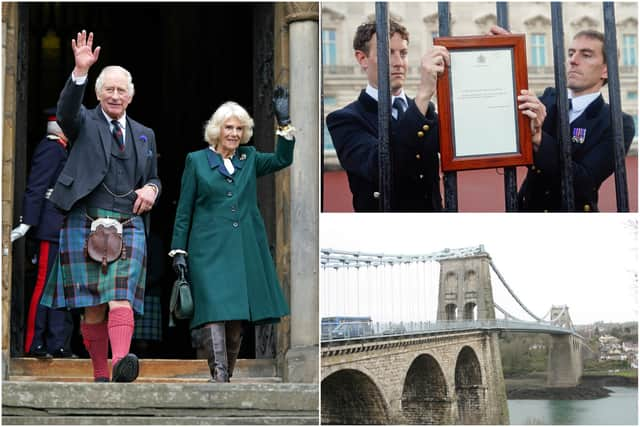Operation Menai Bridge: what happens when Charles III dies, Anglesey suspension bridge - will Camilla be Queen
and live on Freeview channel 276
After his late mother, Queen Elizabeth II, passed away, King Charles III ascended to the throne in accordance with royal family tradition.
Operation London Bridge and Operation Unicorn were the codenames for the preparations implemented following the death of the nation's longest-reigning sovereign, the Queen. And similar plans are in place for the eventual death of Charles - the oldest British monarch to be crowned.
Advertisement
Hide AdAdvertisement
Hide AdCharles is already 75 years old, so it's unlikely that he will be able to duplicate his mother's record-breaking 70 year reign (people don’t typically live until their mid-140s).
So what will occur when Charles is no longer on the throne? Will Camilla reign as Queen? This is your guide to Operation Menai Bridge.
What is Operation Menai Bridge?
Operation Menai Bridge is the code name given to plans related to the death of King Charles III. The plans themselves outline the manner in which his death will be announced, the duration of the official period of mourning, and the specifics of his state funeral.
Advertisement
Hide AdAdvertisement
Hide AdThe plan is extensive and involves multiple government agencies, including the police, military and intelligence services, as well as private organisations and individuals who have specific roles and responsibilities in the event of the monarch’s death.
The operation is designed to ensure that the transition of power is as smooth and orderly as possible, while also respecting the traditions and protocols that surround the death of a monarch.
A state funeral for King Charles III is expected to be held, as it has been for many other monarchs before him. His death arrangements and funeral are being planned with the same meticulous detail as his mother, and the day of his funeral will likely be observed as a national holiday throughout the United Kingdom.


As for the name, the Menai Bridge is a suspension bridge that spans the Menai Strait between the island of Anglesey and mainland Wales, designed by Thomas Telford and completed in 1826.
Advertisement
Hide AdAdvertisement
Hide AdAs the former Prince of Wales, Charles has a connection to the bridge and to Wales in general, and was involved in various organisations and causes in the country before he ascended to the throne.
In 2018, he visited the bridge as part of a tour of Wales, and spoke with local residents and business owners about the importance of preserving the country’s cultural heritage. Additionally, in 2019, he attended a ceremony at the Menai Bridge to mark the 200th anniversary of Telford’s appointment as the engineer for the project.
How long has it been in place?
You may think it rather hasty to already have these plans in place, but planning for the King’s funeral got under way almost immediately following the funeral for Queen Elizabeth II.
Operation London Bridge - the plan that outlined the procedures and protocols to be followed in the event of the death of Queen Elizabeth II - had been in place for many years, and was updated and refined over time as technology and the political landscape evolved.
Advertisement
Hide AdAdvertisement
Hide AdThe code name “London Bridge” was said to have been chosen simply because it is a recognisable landmark in the city of London. It is thought to have had no other symbolic significance.
Would Camilla remain as Queen?
If King Charles III were to die, the next in line to the throne would be his eldest son, Prince William, who would then become King. Camilla would not stay on as Queen, as when a King dies, the Queen Consort (the wife of the King) does not continue to hold the title. Camilla would instead become the “Queen Dowager”.
“Dowager” is a term used to refer to the widow of a peer or a monarch, and Camilla would no longer be the Queen Consort once her husband had passed away. The Queen Dowager does not become the monarch or the head-of-state.
It’s worth noting that the term “Queen Dowager” is not an official title, but rather a courtesy title given to the widow of a King. The title does not come with any formal constitutional duties or powers, but it is a traditional way of acknowledging the widow of a monarch.
Advertisement
Hide AdAdvertisement
Hide AdIn the case of the Queen Mother, she was the widow of King George VI and the mother of the current monarch, Queen Elizabeth II. When George VI died in 1952, his daughter Elizabeth ascended to the throne, and Elizabeth’s mother became known as the Queen Mother. She held this title until her death at the age of 101 in 2002.
The last Queen Dowager in Britain before the Queen Mother was Alexandra of Denmark, the wife of King Edward VII. When King Edward VII passed away in 1910, Alexandra became the Queen Dowager. She held the title until her own death in 1925.
Comment Guidelines
National World encourages reader discussion on our stories. User feedback, insights and back-and-forth exchanges add a rich layer of context to reporting. Please review our Community Guidelines before commenting.
